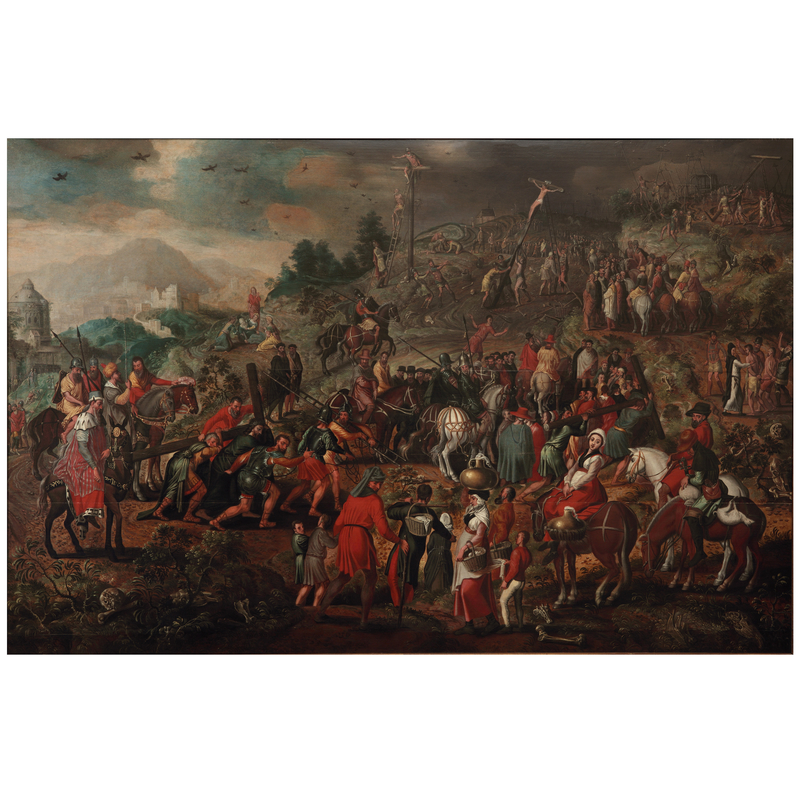After Pieter Aertsen, 'Christ Bearing the Cross'
Global shipping available
- Origin
- Antwerp
- Period
- C. 1550
- Material
- Oil on panel
- Height
- 111.5 cm
- Width
- 169 cm
- Literature
L. Hendrikman & D. Tamis, Brueghel en tijdgenoten, kunst als verborgen verzet?, Zwolle 2021, pp. 210 - 213, cat. no. 71.
M. Friedländer, Early Netherlandish Painting, vol. XIII, Leiden 1975, p. 99, no. 311, pl. 155- Museums
Based on a composition by Pieter Aertsen in the Museum voor Schone Kunsten in Antwerp (see M. Friedländer, Early Netherlandish Painting, vol. XIII, Leiden 1975, p. 99, no. 311, pl. 155). Further examples were in the Gemäldegalerie, Berlin (destroyed in 1945) and in the Kling collection, Stockholm (sale, Christie’s, London, 28 June 1935, lot 9).
- Provenance
Sotheby's, Londen (Engeland), Marshall Brooks, 1946-02-13, lotnr. 61
Sotheby's, Londen (Engeland), 1978-12-13, lotnr. 74
Sotheby's, Londen (Engeland), 1986-02-19 - 1986-02-20, lotnr. 43
Private collection W. Gaskell Harvey
Private collection, Vicenza
Questions about this object?
Please use one of the contact options below:
Description
This painting is based on a composition by Pieter Aertsen (c. 1508-1575) from 1555, currently in the Royal Museum of Fine Arts in Antwerp. It is a more monumental elaboration of an early Kruisdraging by Aertsen from 1552, which was lost in a fire in the Kaiser-Wilhelm-Museum in Berlin in 1945. There is another Kruisdraging after Aertsen’s work from 1555, currently in a private collection in Sweden.
The painting depicts various episodes of the Crucifixion. Among a crowd of peasants going to the city market with their goods and citizens who witness the journey to Golgotha from Jerusalem, Christ, accompanied by Simon the Cyprian, carries the cross past a group around John Evangelista and then past the three Mary's and his pensive mother. The peasants explicitly look away from the scene; they represent those who are unmoved by the passion story, and continue with their trivial and fleeting concerns. To the right of the painting, the horse of one of the peasants carries a tied lamb, symbolic of Christ as the Lamb of God. Further on, one of the criminals carries a cross and the two criminals are being undressed for their execution. Continuing along the road, one sees the cross being erected with Christ already crucified. To the left of him, the good thief (Dismas) is climbing the ladder to be crucified. On the ground next to Dismas, soldiers are playing dice for the clothes of Christ. To the upper right, the cross for the evil thief (Gestas) is being erected. Jerusalem and the city walls can be seen on the left. The bones in the foreground and the vultures in the sky emphasise the significance of Golgotha as a place of skulls.
The painting was painted after the work of Pieter Aertsen, nicknamed 'Lange Pier'. He was educated in his birth town, Amsterdam, but worked for a long time in Antwerp. There, he was registered with the Guild of St. Luke in 1535 and from the 1550s onwards, dated works signed with his trident monogram have been preserved. Works with religious subjects formed an important part of his oeuvre, as did kitchen pieces with still lifes in natural colours. Around 1557, Aertsen was back in Amsterdam where he carried out several large church commissions; works which unfortunately were mostly lost during the Iconoclasm of 1566 and the Alteration in 1578. Preserved fragments show that in these church commissions, Aertsen exhibited the monumental naturalism, which is also to be found in his market and kitchen pieces. As he did in the Crucifixion, Aertsen also applied his qualities as a painter of still life and genre motifs to the painting of religious scenes.







